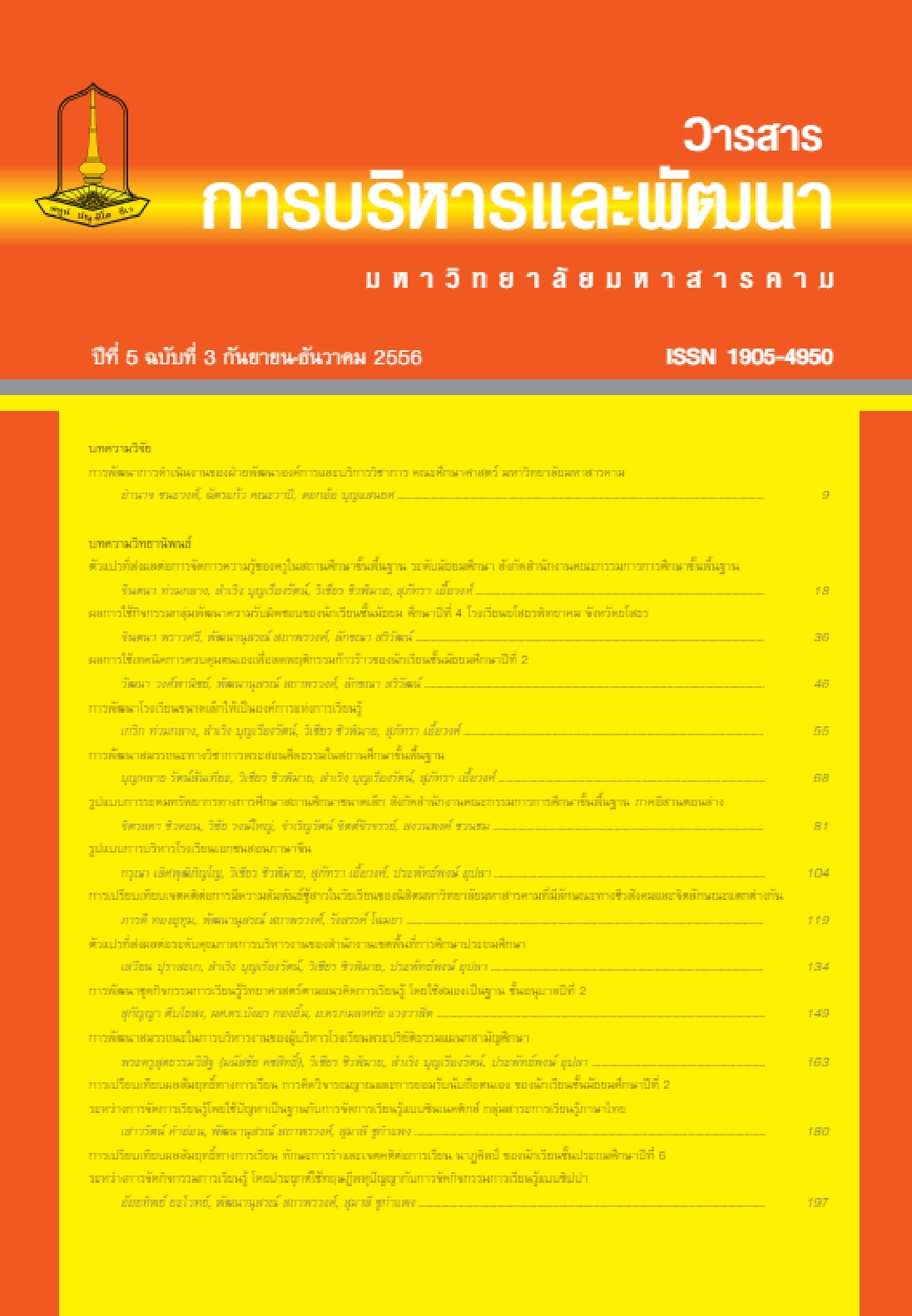การเปรียบเทียบผลสัมฤทธิ์ทางการเรียน ทักษะการรำและเจตคติต่อการเรียนนาฏศิลป์ ของนักเรียนชั้นประถมศึกษาปีที่ 6 ระหว่างการจัดกิจกรรมการเรียนรู้โดยประยุกต์ใช้ทฤษฎีพหุปัญญากับการจัดกิจกรรมการเรียนรู้แบบซิปปา
Main Article Content
บทคัดย่อ
การวิจัยครั้งนี้มีความมุ่งหมายเพื่อ (1) พัฒนาแผนการจัดกิจกรรมการเรียนรู้โดยประยุกต์ใช้ทฤษฎี พหุปัญญาและแผนการจัดแผนการจัดกิจกรรมการเรียนรู้แบบซิปปา กลุ่มสาระการเรียนรู้ศิลปะ สาระนาฏศิลป์ ชั้นประถมศึกษาปีที่ 6 ที่มีประสิทธิภาพตามเกณฑ์ 80 / 80 (2) หาดัชนีประสิทธิผลของแผนการจัดกิจกรรม การเรียนรู้โดยประยุกต์ใช้ทฤษฎีพหุปัญญาและแผนการจัดกิจกรรมการเรียนรู้แบบซิปปา และ (3) เปรียบเทียบผลสัมฤทธิ์ทางการเรียน ทักษะการรำ และเจตคติต่อการเรียนนาฏศิลป์ ของนักเรียนชั้นประถมศึกษาปีที่ 6 ระหว่างการจัดกิจกรรมการเรียนรู้โดยประยุกต์ใช้ทฤษฎีพหุปัญญากับการจัดกิจกรรมการเรียนรู้แบบซิปปา กลุ่มตัวอย่าง ได้แก่ นักเรียนชั้นประถมศึกษาปีที่ 6 โรงเรียนเชิงชุมราษฎร์นุกูล อำเภอเมือง จังหวัดสกลนคร ภาคเรียนที่ 2 ปีการศึกษา 2554 จำนวน 2 ห้องได้มาโดยการสุ่มแบบกลุ่ม (cluster Random Sampling) จำ นวนนักเรียนห้องละ 34 และ 35 คน รวม 69 คน เครื่องมือที่ใช้ในการวิจัย ได้แก่ 1) แผนการจัดกิจกรรมการเรียนรู้โดยประยุกต์ใช้ทฤษฎีพหุปัญญาและแผนการจัดกิจกรรมการเรียนรู้แบบซิปปา จำนวนรูปแบบละ 8 แผนๆ ละ 2 ชั่วโมง 2) แบบทดสอบวัดผลสัมฤทธิ์ทางการเรียน ชนิดเลือกตอบ 4 ตัวเลือก จำนวน 40 ข้อ มีค่าอำนาจจำแนก (B) ตั้งแต่ 0.25 - 0.81 ค่าความเชื่อมั่นทั้งฉบับ (rcc) เท่ากับ 0.91 3) แบบวัดทักษะการรำมีค่าความยาก (p) ตั้งแต่ 0.32 - 0.67 มีค่าอำนาจจำแนก (D) ตั้งแต่ 0.54-0.87 ค่าความเชื่อมั่นทั้งฉบับ (α) เท่ากับ 0.844) แบบวัดเจตคติต่อการเรียนนาฏศิลป์ เป็นแบบมาตราส่วนประมาณค่า 5 ระดับ จำนวน 20 ข้อ มีค่าอำนาจจำแนก (rxy) ตั้งแต่ 0.32 – 0.69 ค่าความเชื่อมั่นทั้งฉบับ (α) เท่ากับ 0.79 และวิเคราะห์ข้อมูลด้วยสถิติ ร้อยละ ค่าเฉลี่ย ส่วนเบี่ยงเบนมาตรฐาน และทดสอบสมมุติฐานโดยใช้ F-test (One-way MANOVA)
ผลการวิจัยปรากฏ ดังนี้1. แผนการจัดกิจกรรมการเรียนรู้โดยประยุกต์ใช้ทฤษฎีพหุปัญญา และการจัดกิจกรรมการเรียนรู้แบบซิปปา สาระนาฏศิลป์ ชั้นประถมศึกษาปีที่ 6 มีประสิทธิภาพเท่ากับ 86.68/83.60 และ 81.39/79.07 ตามลำดับ
2. ดัชนีประสิทธิผลของแผนการจัดกิจกรรมการเรียนรู้โดยประยุกต์ใช้ทฤษฎีพหุปัญญา และการจัดกิจกรรมการเรียนรู้แบบซิปปา สาระนาฏศิลป์ ชั้นประถมศึกษาปีที่ 6 มีค่าเท่ากับ 0.6706 และ 0.5947 แสดงว่านักเรียนมีความก้าวหน้าในการเรียน คิดเป็นร้อยละ 67.06 และ 59.47 ตามลำดับ
3. นักเรียนชั้นประถมศึกษาปีที่ 6 กลุ่มที่ได้รับการจัดกิจกรรมการเรียนรู้โดยประยุกต์ใช้ทฤษฎี พหุปัญญา และกลุ่มที่ได้รับการจัดกิจกรรมการเรียนรู้แบบซิปปา มีผลสัมฤทธิ์ทางการเรียนหลังเรียนไม่แตกต่างกัน แต่กลุ่มที่ได้รับการจัดกิจกรรมการเรียนรู้แบบซิปปามีทักษะการรำและเจตคติต่อการเรียนนาฏศิลป์ สูงกว่ากลุ่มที่ได้รับการจัดกิจกรรมการเรียนรู้โดยประยุกต์ใช้ทฤษฎีพหุปัญญา อย่างมีนัยสำคัญทางสถิติ (p .003)
Downloads
Article Details
เอกสารอ้างอิง
Aree Sanhachawee. (2000). Intelligences In the Classroom: Teaching Strategies to Develop Multi-Dimensions of Intelligences. Bangkok: Books Development Center, Department of Academy.
Cherngchum Ratnukoon School. (2010). Curriculum of Cherngchum Ratnukoon School B.E.2553, According to Basic Educational Core Curriculum B.E. 2551. Sakonnakhorn.
Malee Thiboonbun. (2010). Learning Outcomes of Arts Content Strands, Musical Theme for Mathayomsuksa 1 Level, Using CIPPA Learning Model. Independent Study on Master of Education Degree. Mahasarakham: Mahasarakham University.
Nittaya Satnakho. (2011). The Learning Outcomes of CIPPA learning model in Arts Content Strand, Entitled Creating of musical Posture, for Prathomsuksa 6 Level. Independent Study on Master of Education Degree. Mahasarakham: Mahasarakham University.
Nirat Jantharajit. (2010). Learning For Thinking. Maha Sarakham: Maha Sarakham University Publishing.
Prakorbkul Maneewan. (2011). Comparisons of Learning Achievement, Analytical Thinking Abilities And Emotional Quotient of Prathomsueksa 3 Students Who Learned Using Organization of Learning Based on the Multiple Intelligences Theory and the CIPPA Model. Thesis on Master of Education Degree. Mahasarakham: Mahasarakham University.
Pradit Khi-inti. (2009). Comparisons of Learning Outcomes on Yoay Ethnic’s Folkdance, of Prathomsueksa 6 Students Between Using Organization of Learning Activities by the Multiple Intelligences Theory Approach and the Conventional Learning Approach. Thesis on Master of Education Degree. Mahasarakham: Mahasarakham University.
Punyanuch Chaiyamoon. (2007). A Development of Web – based Courseware Based – on the Multiple Intelligences Theory and Creative Thinking in the Group of Art Learning Content, Entitled “Basic of Thai Dancing Art” for Prathomsueksa 6. Thesis on Master of Education Degree. Mahasarakham: Mahasarakham University.
Petcharat Suwannachai. (2010). Learning Outcomes by Using Applied The Multiple Intelligences Theory Approach, in Classical Dance Content, Entitled Folk Dance on Sufficient Economy Theme for Prathomsuksa 5 Level. Independent Study on Master of Education Degree. Mahasarakham: Mahasarakham University.
Peera Rattanawijit and others. (2001). The Application of Multiple Intelligences Theory For Learning Reform. Bangkok: Thammasan Publishing.
Pirapong Sensai. (2004). The Stream of Easan Dancing. Kalasin: Prasarn Publishing.
Tissana Khammanee. (1999). The Students – Centered Learning: CIPPA Model. Journal of Education. 27 (3): 1 – 17 , March –June.
Tissana Khammanee. (2010). Strategies of Teaching: Knowledge for Effective Learning Process. 13th edition, Bangkok: Chulalongkorn University Publishing.
Uthumporn Kronghen. (2011). The Outcomes of Learning Activities in Classical Dance, Entitled Creating of Dancing Posture for Mathayomsuksa 2 Level, Using The Multiple Intelligences Theory Approach. Independent study on Master of Education Degree. Mahasarakham: Mahasarakham University.
Wilailak Amnajdee. (2010). The Outcomes of Learning Activities in Arts Content Strands (Classical Dance Theme), Entitled Folk Dance on Pla Shado Theme, Based on The Multiple Intelligences Theory Approach for Mathayomsuksa 1 Level. Independent study on Master of Education Degree. Mahasarakham: Mahasarakham University.
Wood, Samuel E.; Wood, Ellen Green ; Boyd, Denise. (2011). The World of Psychology. 7th ed. Boston: Pearson Education, Inc.
Yaowarate Pramtaeng. (2007). Development for Learning Plans Using The Multiple Intelligences Theory Approach, Entitled Folk Art of Thailand, Arts Content Strands For Prathomsuksa 6 level. Independent study on Master of Education Degree. Mahasarakham: Mahasarakham University.

